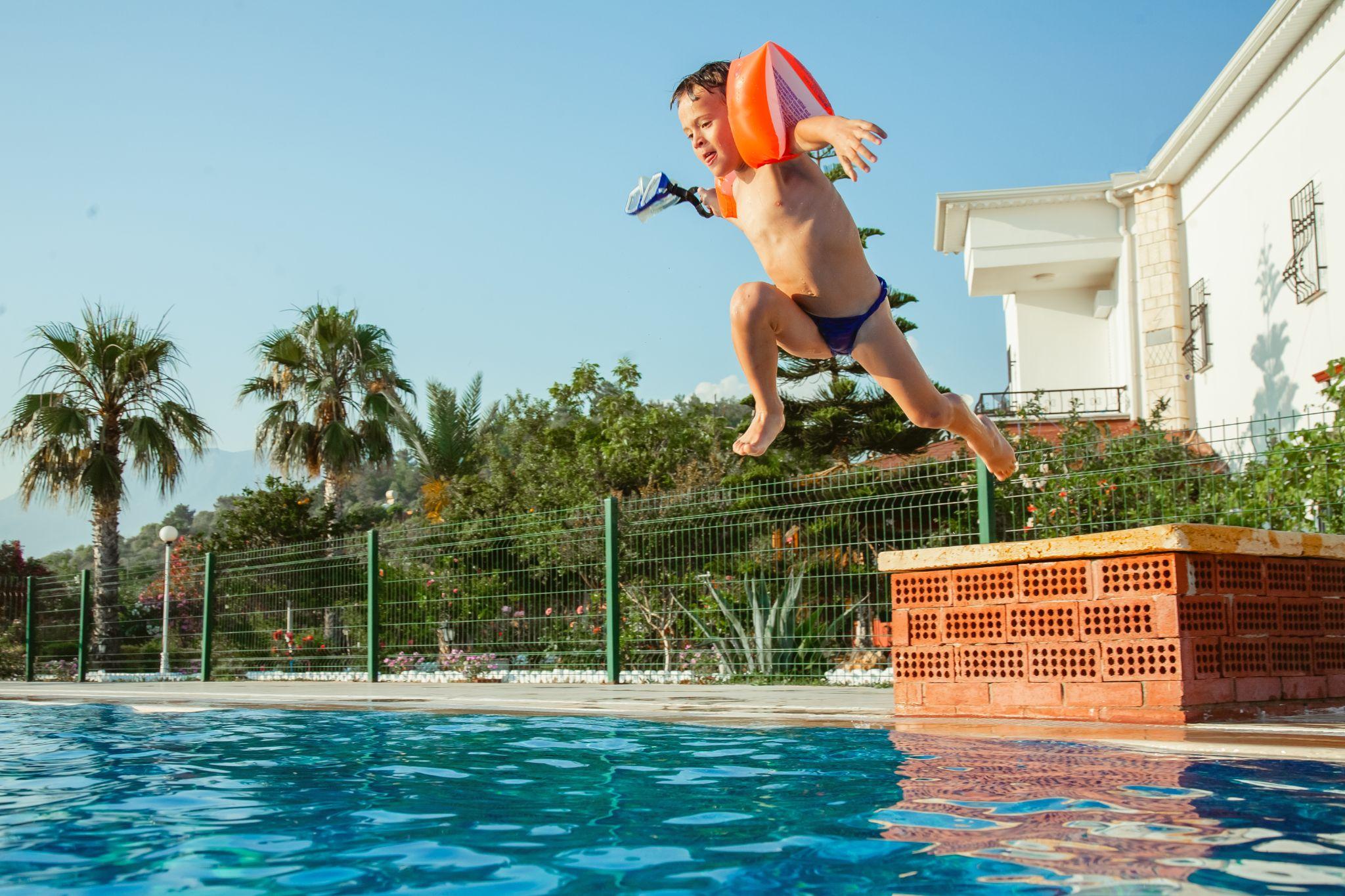Pool fencing is not the first thing that comes to mind when you think of floating around your brand new pool. But if you’re thinking about a swimming pool in, a pool fence is an absolutely essential part of the process. Factoring in your swimming pool fence with your pool design won’t just make sure you end up with something stylish, but something that’s safe and compliant too. There are very specific standards surrounding pool fences in Victoria that need to be adhered to. That’s why we’ve put together the ultimate guide to pool fence safety and standards. We’ll cover absolutely everything you need to know, so you and your family can swim safely in no time.
Our ultimate guide to pool fence safety and standards includes:
- Pool fencing regulations.
- Pool fencing standards.
- The pool fencing compliance process.
- Non-compliance and how to overcome it.
- Creating safe zones around your fence.
- Pool fence maintenance.
- Choosing the right contractor.
Pool fencing regulations – introduction
Let’s get started by covering the basics. When putting up a swimming pool fence it’s important that you erect it in compliance with your local government laws. Not meeting pool fencing requirements could lead to costly delays, fines, and even potential legal issues, but don’t worry, this guide is here to help you avoid all of that.
Before we get into all the regulation details, here’s a quick overview. Victoria is the most recent state to undertake safety reforms which came into effect on the 1st of December 2019. The regulations require all swimming pools and spas with a depth greater than 30cm to be surrounded by compliant pool fencing. Your pool fence must meet a specific height, and design, and provide adequate protection to prevent unauthorised access and potential drowning. You’ll also need to register your pool with your local council, who will send someone to your home to ensure that your pool fence is compliant. With this guide, it’ll all seem simple.
Now let’s look at the standards and regulations in detail.
Pool fencing compliance standards
You’ll note that the official regulations often refer to your pool fence as a ‘safety barrier’. The Australian Standard AS1926.1-2012: Safety Barriers for Swimming Pools is the current national standard that governs pool fences in Victoria. The Australian Standard AS1926.1-2012 applies to all pools, including inflatable pools and spas. Below, you’ll find all the details you’ll need to know to ensure your pool fence is compliant.
Pool Fencing Requirements
Here are the key requirements for safety barriers (pool fences) as set out in the Australian Standard:
- Your pool fence must be at least 1.2m high (as measured from the finished ground level).
- Your pool fence mustn’t leave a gap at the bottom bigger than 10cm from the finished ground level.
- If a boundary fence is part of the pool fence, the barrier must be 1.8m high.
- Pool owners must maintain a ‘non-climbable’ zone around the pool.
Making sure your pool fence gate is compliant
Now that you’ve got the pool fence guidelines sorted, you’ll need to make sure that your pool fence gate is compliant as well. Australian Standard AS 1926.1 outlines that gates need to be:
- Hung so that they only swing outwards. i.e. away from the pool area.
- they must also be able to swing freely through its arc of operation, be fitted with a self-closing device and be fitted with a latching device.
- A pool gate that is not self-closing or does not have a latching device should be permanently secured until such time as the device/s can be installed.
Pool fence inspections
Once your swimming pool has been registered with your local council, you’ll need to arrange an inspector for an inspection. This can be carried out by either:
- A registered building surveyor,
- A registered building inspector,
- A municipal building surveyor.
Certificate of Barrier Compliance
If the inspector determines that your pool fence complies with the standards, they’ll issue a Certificate of Barrier Compliance. As the owner of the land that the pool is on, you then need to lodge the certificate with your council within 30 days of the date of issue of the certificate.
When the council receives the certificate, they’ll send you a written notice, which confirms the date the certificate was lodged and includes the date by which the next certificate is required to be lodged, which is always four years after the previous certificate.
What happens if my pool fence isn’t compliant?
If the inspector determines that your pool fence isn’t compliant, they’ll issue you a certificate of barrier non-compliance as well as a written notice specifying which matters must be addressed to bring the pool barrier into compliance, the amount of time you have to bring it up to compliance (a maximum of 60 days), and when the inspector intends to reinspect your pool fence.
If, once they perform the reinspection, the inspector determines that your pool fence is compliant, they’ll issue a certificate of barrier compliance, which you then need to lodge with the council.
It’s worth noting that if your pool fence is still non-compliant, but the inspector is satisfied that progress has been made towards bringing the fence into compliance, they may allow you an additional seven days to bring it to full compliance.
Pool fencing non-compliance penalties
Swimming pool fences that don’t meet safety requirements face fines for non-compliance. If the inspector issues a certificate of barrier non-compliance, they’ll lodge it with the relevant council and provide you with a copy. The council will notify you and you’ll have to pay a fee by the due date specified in the notice.
Here are the penalties for non-compliance for Victoria:
- Maximum penalty for lodging a certificate of barrier non-compliance with council – $397.54
- Failure to lodge certificate of barrier compliance by the date specified – up to $1,849.20
- Failure to lodge certificate of barrier non-compliance by date specified – up to $1,849.20
- Failure to comply with barrier improvement notice by date specified – up to $1,849.20
Creating a safe zone around your pool fence
Part of the pool fence safety requirements extend past the fence itself. To keep children and pets from climbing into the pool area, you need to create a ‘safe zone’ around the entire length of your pool fence. The guidelines are simple:
-
On the outside of your fence, all climbable objects must be at least 900mm away from the fence.
-
On the inside of your fence, all non-climbable objects must not be within 300mm of the pool fence.
When should I put my fence up?
Given the strict guidelines, most people aren’t sure if they should erect their swimming pool fence before or after the swimming pool is put in. The short answer is afterwards – but, there are requirements here as well, because you’ll need a temporary fence up while the pool is being installed.
Your pool contractor should include temporary fencing in your pool quote before you sign a contract. You must ensure your temporary fencing complies with the same standards as your finalised established fencing, as outlined in this article.
Maintaining your pool fence
It’s important that you make sure your pool fence is fully functional on an ongoing basis. Pool fence maintenance includes regularly checking that the:
- Gate operates as it did when it was installed.
- The latching device operates as it did when it was installed.
- Your fence doesn’t have any additional gaps, rust and wear and tear that would render it ineffective.
- All pool fence bolts are tight and in good order.
Because your pool fence exists to keep your family safe, maintenance is really important. Remember, your certificate of barrier compliance gets reinstated every four years, so making sure you maintain your pool fence is a legal as well as a safety matter. It’s recommended that to keep your pool fence safe and compliant and that you use a licensed pool technician, builder or fencing contractor for checks.
Complete overview of pool fencing safety standards
Here is a recap of everything you need to know to ensure that your pool fence complies with pool safety law standards:
- By law, your pool or spa needs to be registered with your local council.
- If your pool has a depth of 30cm or more (300mm), it’s required to be surrounded by a pool fence. This includes inflatable pools and spas.
- All pools must be fully enclosed by a fence that’s at least 1200mm in height.
- The bottom of the pool fence and gate must be no more than 100mm off the ground.
- If the horizontal rails are 900mm or more apart, the vertical rails can’t be more than 100mm apart.
- If the horizontal rails are less than 900mm apart, the vertical rails must be no more than 10mm wide.
- The gate must open away from the pool and never be propped open.
- The gate must be self-closing from any position and self-latching.
- The gate latch must be located at least 1500mm above the ground and at least 1400mm above the top part of the horizontal railings. It can also be located on the inside of the fence.
- All climbable objects must be at least 900mm away from the fence on the outside.
All non-climbable objects must not be within 300mm of the pool fence on the inside.
You must display a CPR sign prominently around the pool area (it should be legible from at least 3m away).
- You can’t have door access to the pool from your house. Any windows around the pool mustn’t open more than 125mm or should have screens and/or locks.
- Before selling, leasing or renting a property with a pool, you must obtain a pool safety certificate.
Choosing the right pool fencing contractor
Now you know everything you need to about erecting a pool fence around your swimming pool and how to ensure it’ll be compliant. When choosing a contractor to erect it for you, make sure you choose a licensed, reputable fencing company, that will be able to advise exactly what type of pool fence you need to make sure you’re complying with Australian and state laws.
ToughGuard leads the way in swimming pool fencing, with a commitment to delivering the safest, strongest, and most reliable fencing products. Our dedication to quality, state-of-the-art manufacturing techniques, rigorous third-party testing, and continuous innovation means we consistently set industry benchmarks.
For any guidance on fencing, design and planning, or fence compliance, get in touch with our team. We have a wealth of knowledge and are ready to help you find a swimming pool fence that is as stylish as it is safe and compliant.





